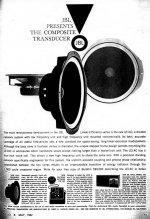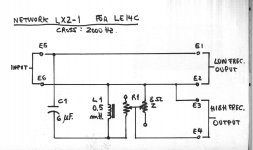Wow, the bold highlighted part is wrong...
I comprehended your intention OK - sorry to have given offence.
A typical (high pass only) 2-way car speakers are 4ohms, the tweeter and woofer would each have to be much more than 4ohms otherwise impedance drop low enough to damage the amp, since the woofer overlaps with the tweeter... right?If they are car speakers, they are likely to be 4 ohm.
If that is the case, then it would be best just to half the value of the currently fitted capacitor.
No. The tweeter is crossed over so the power at low frequencies doesn't reach it, and since most of the power comes with LF, the amplifier effectively sees only the woofer. This isn't completely true, but it's close enough for a working point IMHO.
Wrong, I'm afraid.right?
The woofer and tweeter do not form a parallel combination in the way you think.
Consider a 4 ohm coaxial car speaker:
Due to crossover action, the amplifier sees the 4 ohm woofer as a load at low/mid frequencies and the 4 ohm tweeter as a load at high frequencies.
Hence the load across all frequencies is effectively 4 ohm.
Like kodabmx's explanation, this is a simplification. Suffice it to say the parallel resistor rule does not apply when a crossover is involved.
Thank you all for bearing with me. So, in sub $50 speakers with 3" to 5" woofers that only have a single capacitor high pass filter, no low pass "proper crossover", are the tweeters set so high that that the don't over with the higher woofer frequencies (3khz-6khz) or is there something else happening with the power throughput?Wrong, I'm afraid.
The woofer and tweeter do not form a parallel combination in the way you think.
Consider a 4 ohm coaxial car speaker:
Due to crossover action, the amplifier sees the 4 ohm woofer as a load at low/mid frequencies and the 4 ohm tweeter as a load at high frequencies.
Hence the load across all frequencies is effectively 4 ohm.
Like kodabmx's explanation, this is a simplification. Suffice it to say the parallel resistor rule does not apply when a crossover is involved.
Although the woofer does not have an external electrical low pass filter, it will have its own 'built-in' filter due to its voice coil impedance rising with frequency plus a natural roll-off due to the mechanical properties of the woofer.
That's right, the mechanical filter is not very well known these days. It seems that it would be imperative to place a coil to attenuate the mid-high zone that receives the twoofer, but it is not always necessary, there are other solutions.Although the woofer does not have an external electrical low pass filter, it will have its own 'built-in' filter due to its voice coil impedance rising with frequency plus a natural roll-off due to the mechanical properties of the woofer.
A large cone - and its respective coil - with studied corrugations and Aquaplas (*) treatment , the HF don't even tickle.
JBL used it on the LE14C. There is no low pass, the full range of frequencies range goes to the mid-bass cone. The undulations are not only to give rigidity, they do not reach the edge of the coil, they stop before because they attenuate the high frequency waves to a totally smooth point, the one that helps to emphasize the midrange.
(*) http://www.audioheritage.org/vbulletin/showthread.php?26329-What-is-Aquaplas
Attachments
Last edited:
All right, you already know my English language limitations and the effort it takes me to participate here.... 👍 😉I comprehended your intention OK - sorry to have given offence.
- Home
- Design & Build
- Parts
- Capacitor calculation for high pass filter


